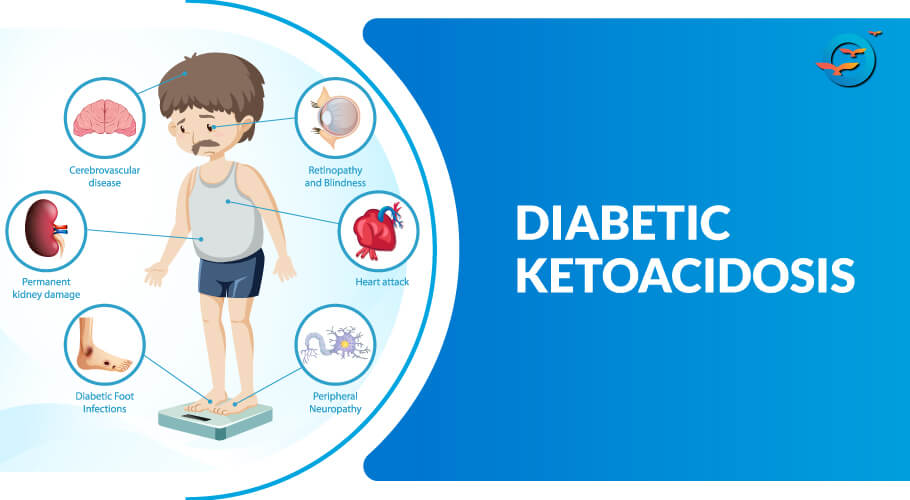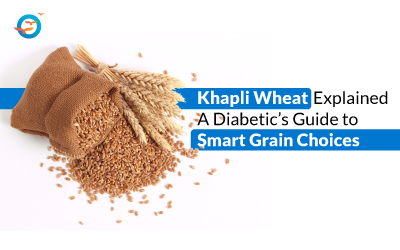Diabetic Ketoacidosis - Symptoms & Causes

Diabetic ketoacidosis (DKA) is a serious and potentially life-threatening complication of diabetes that requires immediate medical attention. If you or someone you know has diabetes, it's important to understand the signs, symptoms, and causes of DKA to prevent this dangerous condition from occurring.
In this blog post, we'll delve into everything you need to know about DKA so that you can keep yourself or your loved ones safe and healthy. So brace yourself to explore the ins and outs of Diabetic ketoacidosis!
Diabetic ketoacidosis
Diabetic ketoacidosis (DKA) occurs when your body produces high levels of blood acids called ketones. Ketones are produced when your body breaks down fat for energy. DKA can happen to anyone with diabetes, but it is most common in people with type 1 diabetes.
DKA usually happens when there is an imbalance of insulin in the body. Insulin is a hormone that helps to control blood sugar levels. When there is not enough insulin, or if the body does not respond properly to insulin, blood sugar levels can rise too high. This can cause the body to produce ketones as a way to use up excess glucose. If ketone production becomes too high, it can lead to DKA.
DKA is a serious medical emergency and needs to be treated straight away. If left untreated, DKA can lead to coma and even death.
What Are the Symptoms of Diabetic Ketoacidosis?
- Excessive thirst and urinating more often than usual
- Feeling very tired
- Nausea and vomiting
- Flushed skin
- Abdominal pain
- Difficulty breathing
If you experience any of these symptoms, it's important to contact your doctor or diabetes healthcare team immediately.
Causes of Diabetic ketoacidosis
There are three primary causes of diabetic ketoacidosis:
1. Insulin deficiency
2. Excessive glucagon activity
3. Insufficient fluid intake
Insulin is a hormone that helps the body to use glucose for energy. When insulin levels are low, the body cannot use glucose effectively, so it breaks down stored fat for energy instead. This process produces ketones, which can build up in the blood and cause ketoacidosis.
Excessive glucagon activity can also lead to ketoacidosis. Glucagon is a hormone that raises blood sugar levels. When it is overactive, it can cause the body to produce too many ketones.
Insufficient fluid intake can also cause diabetic ketoacidosis. When the body does not have enough fluids, it cannot flush out ketones efficiently and they build up in the blood.
Risk factors for diabetic ketoacidosis
There are a number of risk factors that can contribute to the development of diabetic ketoacidosis. These include:
- Having type 1 diabetes
- Having uncontrolled diabetes
- Having a history of ketoacidosis
- Having an infection or illness
- Taking certain medications or having certain medical conditions
If you have any of these risk factors, it's important to be aware of the signs and symptoms of ketoacidosis and to seek medical attention if they develop.
Alternatives to Treating Diabetic ketoacidosis
Alternatives to treating diabetic ketoacidosis
If you or a loved one have diabetes, it's important to be aware of ketoacidosis. While ketoacidosis is most often seen in people with type 1 diabetes, it can also occur in people with type 2 diabetes.
There are several treatments for ketoacidosis, but not all of them may be right for you. Here are some alternatives to diabetic ketoacidosis treatment:
- Insulin therapy:
Insulin is the most common and effective treatment for ketoacidosis. It helps to regulate blood sugar levels and prevent ketoacidosis from occurring. - Glucagon:
Glucagon is a hormone that helps to raise blood sugar levels. It can be used as an alternative to insulin therapy in some cases of ketoacidosis. - Sodium bicarbonate:
Sodium bicarbonate is a salt that can help to neutralize the acids in the blood. It's sometimes used along with insulin therapy to treat ketoacidosis. - Fluids and electrolytes:
IV fluids and electrolytes are often used to treat dehydration and low blood sugar levels associated with ketoacidosis. - DKA protocol:
The DKA protocol is a set of guidelines that must be followed when treating someone with ketoacidosis. It includes monitoring blood sugar levels, administering insulin, and giving IV fluids and electrolytes if needed.
We all know "Prevention is better than Cure". By controlling our blood sugar levels well, we can reverse diabetes and avoid complications like diabetic ketoacidosis. Freedom from Diabetes (FFD) has saved thousands of lives by helping them reverse diabetes and metabolic disorders!
To learn more about What is the Role of Gut microbiome in weight management, visit our blog.
It's incredible how FFD has freed people from insulin/medicines both while providing them with a healthier lifestyle. Joining FFD means taking control of your health in a way you never thought possible. Say goodbye to fear and start living your best. Join FFD today!
FAQs
What is Diabetic Ketoacidosis (DKA)?
Diabetic ketoacidosis (DKA) occurs when your body produces high levels of blood acids called ketones. Ketones are produced when your body breaks down fat for energy. DKA can happen to anyone with diabetes, but it is most common in people with type 1 diabetes.
What are the main symptoms of Diabetic Ketoacidosis?
These are the symptoms of Diabetic Ketoacidosis? Excessive thirst and urinating more often than usual, Feeling very tired, Nausea and vomiting, Flushed skin, Abdominal pain, Difficulty breathing.
What causes Diabetic Ketoacidosis?
1. Insulin deficiency
2. Excessive glucagon activity
3. Insufficient fluid intake
Can Diabetic Ketoacidosis be prevented?
Yes, manage diabetes effectively which is help to prevent to DKA. You have to monitor insulin level, always stay hydrated, and healthcare consulatant.
Image source: https://www.nipro-group.com/en/inspire/diabetic-ketoacidosis-dka-why-should-it-matter-me

